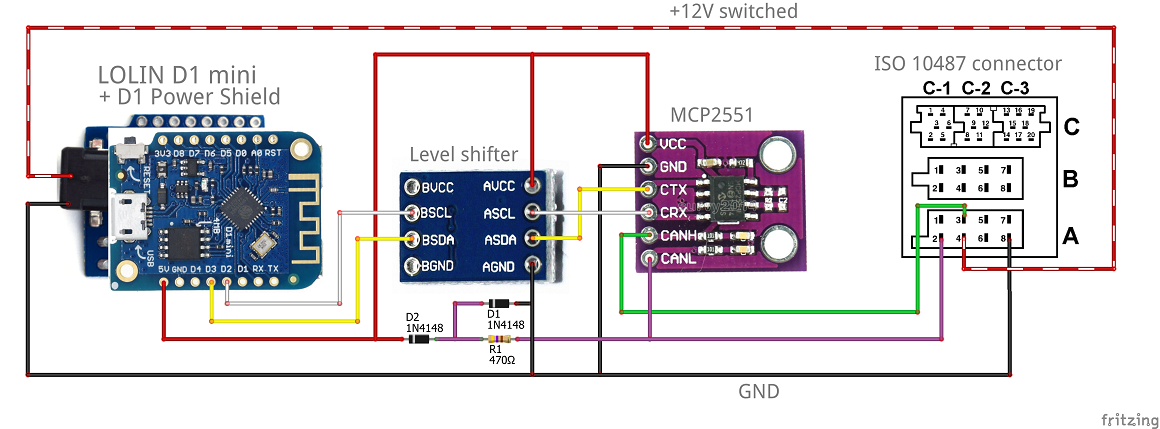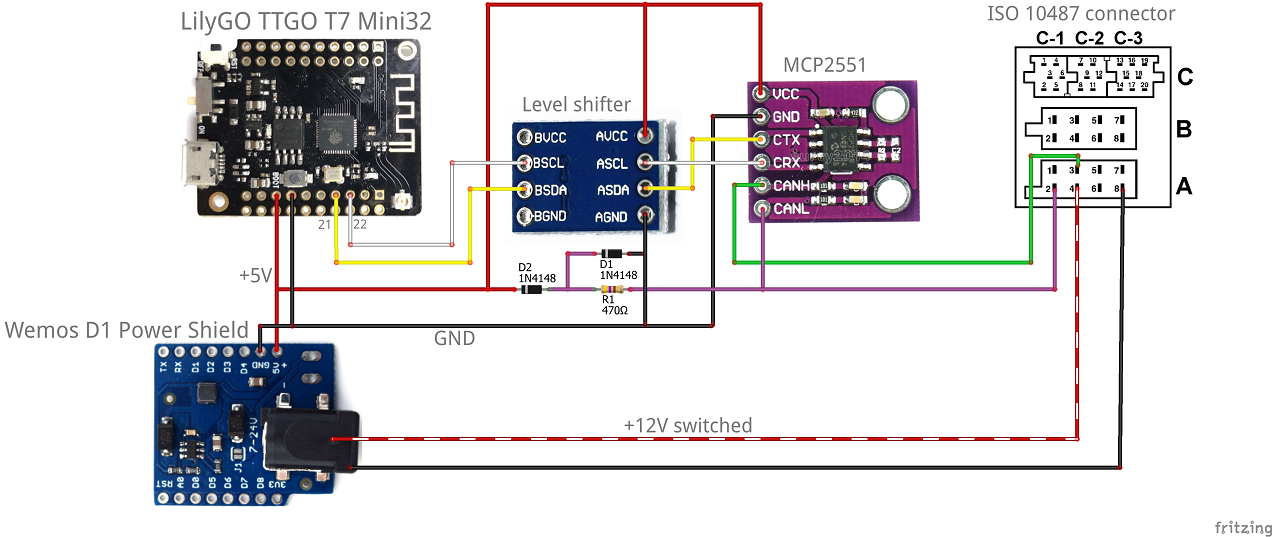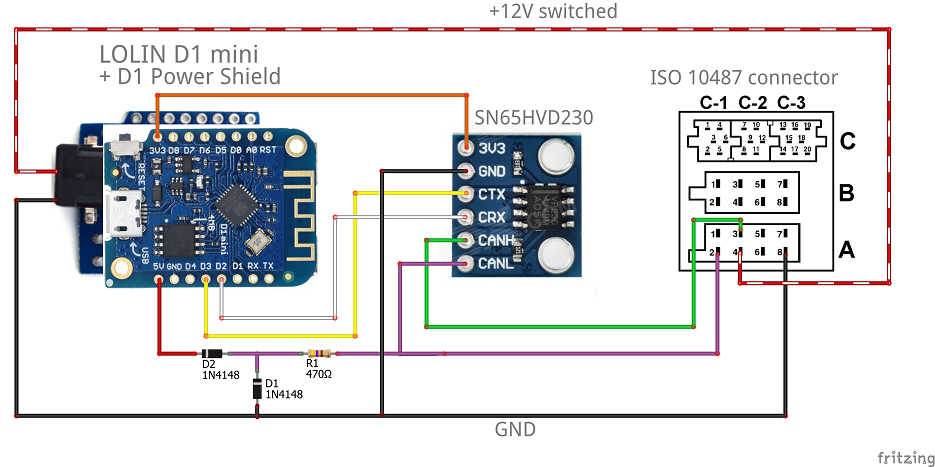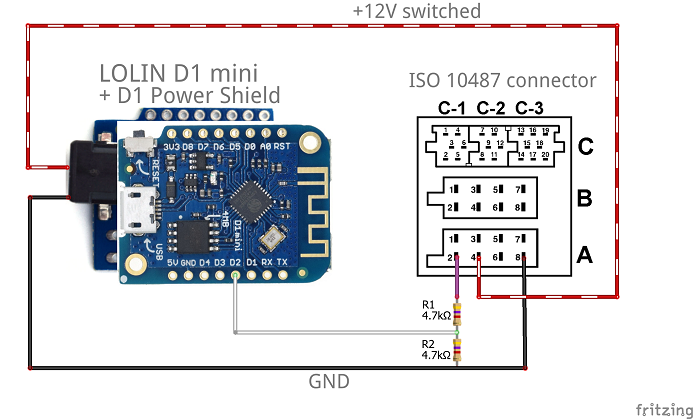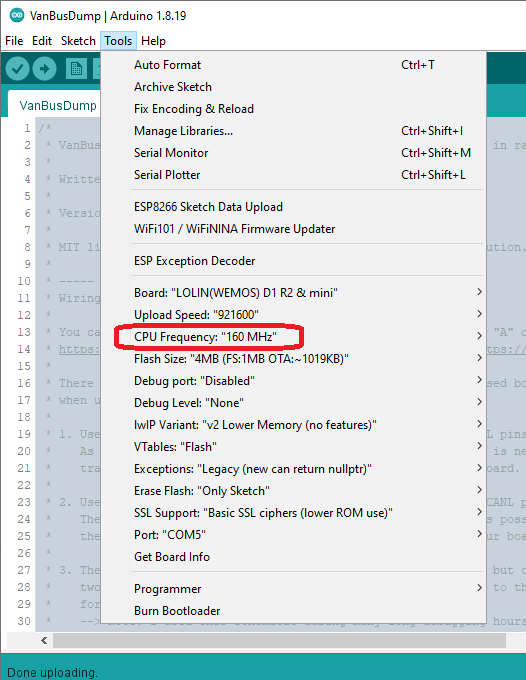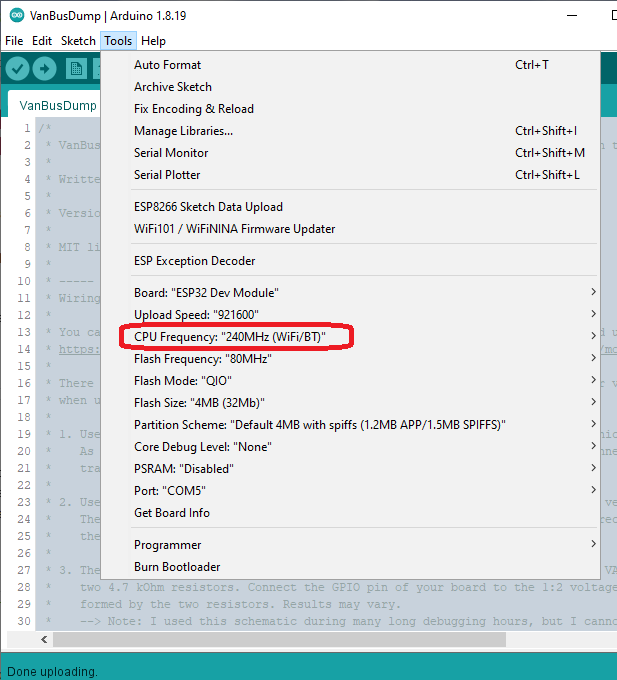Reading and writing packets from/to PSA vehicles' VAN bus.
This module allows you to receive and transmit packets on the "VAN" bus of your Peugeot or Citroen vehicle.
VAN bus is pretty similar to CAN bus. It was used in many cars (Peugeot, Citroen) made by PSA.
In the beginning of 2000's the PSA group (Peugeot and Citroen) used VAN bus as a communication protocol between the various comfort-related equipment. Later, around 2005, they started to replace this protocol in their newer cars with the CAN bus protocol, however some models had VAN bus inside them until 2009. This overview lists vehicles that are supposedly fitted with a VAN (comfort) bus.
Both the ESP8266 / ESP8285 and ESP32 platforms are supported by this library.
You can usually find the VAN bus on pins 2 and 3 of ISO block "A" of your head unit (car radio). See https://en.wikipedia.org/wiki/Connectors_for_car_audio and https://github.com/morcibacsi/esp32_rmt_van_rx#schematics .
There are various possibilities to hook up a ESP8266/ESP32 based board to your vehicle's VAN bus:
-
Use a MCP2551 transceiver, connected with its CANH and CANL pins to the vehicle's VAN bus. As the MCP2551 has 5V logic, a 5V ↔ 3.3V level converter is needed to connect the CRX / RXD / R pin of the transceiver, via the level converter, to a GPIO pin of your ESP8266/ESP32 board. For transmitting packets, also connect the CTX / TXD / D pins of the transceiver, via the level converter, to a GPIO pin of your ESP8266/ESP32 board.
A board with the MCP2551 transceiver can be ordered e.g. here or here.
Example schema using a Wemos D1 mini (ESP8266 based):
Example schema using a LilyGO TTGO T7 Mini32 (ESP32 based):
👉 Notes:
The two terminator resistors R3 and R4 (2 x 100 Ohm, near the CANH and CANL pins) on this transceiver board are meant for operating inside a CAN bus network, but are not necessary on a VAN bus. In fact, they may even cause the other equipment on the bus to malfunction. If you experience problems in the vehicle equipment, you may want to remove (unsolder) these terminator resistors. See also this issue.
- CANH of the transceiver is connected to VAN BAR (DATA B), CANL to VAN (DATA). This may seem illogical but in practice it turns out this works best.
- The clamping circuit (D1, D2, R1) seems to (somehow) help in reducing the amount of bit errors (packet CRC errors).
-
Use a SN65HVD230 transceiver, connected with its CANH and CANL pins to the vehicle's VAN bus. The SN65HVD230 transceiver already has 3.3V logic, so it is possible to directly connect the CRX / RXD / R pin of the transceiver to a GPIO pin of your ESP8266/ESP32 board. For transmitting packets, also connect the CTX / TXD / D pins of the transceiver to a GPIO pin of your ESP8266/ESP32 board.
A board with the SN65HVD230 transceiver can be ordered e.g. here or here.
👉 Notes:
The terminator resistor R2 (120 Ohm, near the CANH and CANL pins) on this transceiver board is meant for operating inside a CAN bus network, but is not necessary on a VAN bus. In fact, it may even cause the other equipment on the bus to malfunction. If you experience problems in the vehicle equipment, you may want to remove (unsolder) the R2 terminator resistor. See also this issue.
- CANH of the transceiver is connected to VAN BAR (DATA B), CANL to VAN (DATA). This may seem illogical but in practice it turns out this works best.
- The clamping circuit (D1, D2, R1) seems to (somehow) help in reducing the amount of bit errors (packet CRC errors).
- The simplest schematic is not to use a transceiver at all, but connect the VAN DATA line to GrouND using two 4.7 kOhm resistors. Connect the GPIO pin of your ESP8266/ESP32 board to the 1:2 voltage divider that is thus formed by the two resistors. This is only for receiving packets, not for transmitting. Results may vary.
👉 Notes:
- This schematic seems to work well only with an ESP8266-based board, like the Wemos D1 mini. With an ESP32-based board I get a lot of CRC errors.
- I used this schematic during many long debugging hours, but I cannot guarantee that it won't ultimately cause your car to explode! (or anything less catastrophic)
Before proceeding with this project, make sure you check all the following prerequisites.
See Arduino IDE
An example of an ESP8266-based board is the Wemos D1 mini.
For an ESP8266-based board you will need to install the ESP8266 Board Package.
I am currently using version 2.6.3 but other versions may also be working fine.
Follow this tutorial to install the ESP8266 Board Package.
In the Arduino IDE, go to the "Sketch" menu → "Include Library" → "Manage Libraries..." and install the Vehicle Area Network (VAN) bus packet reader/writer library. Hint: type "vanbus" in the search box.
For more explanation on using the Arduino library manager, you can browse to:
- this tutorial from Arduino, and
- this explanation from Adafruit
In the Arduino IDE, go to the "Tools" menu, and choose:
- CPU frequency: 160 MHz
Here is a picture of board settings that have been tested to work:
An example of an ESP32-based board is the LilyGO TTGO T7 Mini32.
For an ESP32-based board you will need the ESP32 board package installed.
I am currently using version 1.0.6 but other versions may also be working fine.
Follow this tutorial to install the ESP32 Board Package.
See section 'Install the VAN Bus Library', above.
In the Arduino IDE, go to the "Tools" menu, and choose:
- CPU frequency: 240 MHz
Here is a picture of board settings that have been tested to work:
Add the following line to your .ino sketch:
#include <VanBus.h>For receiving and transmitting packets:
- Add the following lines to your initialisation block
void setup():
int TX_PIN = D3; // GPIO pin connected to VAN bus transceiver input
int RX_PIN = D2; // GPIO pin connected to VAN bus transceiver output
TVanBus::Setup(RX_PIN, TX_PIN);- Add e.g. the following lines to your main loop
void loop():
TVanPacketRxDesc pkt;
if (VanBus.Receive(pkt)) pkt.DumpRaw(Serial);
uint8_t rmtTemperatureBytes[] = {0x0F, 0x07, 0x00, 0x00, 0x00, 0x00, 0x70};
VanBus.SyncSendPacket(0x8A4, 0x08, rmtTemperatureBytes, sizeof(rmtTemperatureBytes));If you only want to receive packets, you may save a few hundred precious bytes by using directly the VanBusRx
object:
- Add the following lines to your initialisation block
void setup():
int RX_PIN = D2; // GPIO pin connected to VAN bus transceiver output
VanBusRx.Setup(RX_PIN);- Add the following lines to your main loop
void loop():
TVanPacketRxDesc pkt;
if (VanBusRx.Receive(pkt)) pkt.DumpRaw(Serial);The following methods are available for the VanBus object:
Interfaces for both receiving and transmitting of packets:
Interfaces for receiving packets:
bool Available()bool Receive(TVanPacketRxDesc& pkt, bool* isQueueOverrun = NULL)uint32_t GetRxCount()int QueueSize()int GetNQueued()int GetMaxQueued()void SetDropPolicy(int startAt, bool (*isEssential)(const TVanPacketRxDesc&) = 0)
Interfaces for transmitting packets:
bool SyncSendPacket(uint16_t iden, uint8_t cmdFlags, const uint8_t* data, size_t dataLen, unsigned int timeOutMs = 10)bool SendPacket(uint16_t iden, uint8_t cmdFlags, const uint8_t* data, size_t dataLen, unsigned int timeOutMs = 10)uint32_t GetTxCount()
Start the receiver listening on GPIO pin rxPin. The transmitter will transmit on GPIO pin txPin.
Dumps a few packet statistics on the passed stream. Passing false to the longForm parameter generates
the short form.
Returns true if a VAN packet is available in the receive queue.
Copy a VAN packet out of the receive queue, if available. Otherwise, returns false.
If a valid pointer is passed to 'isQueueOverrun', will report then clear any queue overrun condition.
Returns the number of received VAN packets since power-on. Counter may roll over.
Returns the number of VAN packets that can be queued before packets are lost.
Returns the number of VAN packets currently queued.
Returns the highest number of VAN packets that were queued.
Implements a simple packet drop policy for if the receive queue is starting to fill up.
Packets are dropped if the receive queue has startAt packets or more queued, unless a packet is identified
as "important". To identify such packets, pass a function pointer via the isEssential parameter. The passed
function is called within interrupt context, so it must have the ICACHE_RAM_ATTR attribute.
Example:
bool ICACHE_RAM_ATTR IsImportantPacket(const TVanPacketRxDesc& pkt)
{
return
pkt.DataLen() >= 3 &&
(
pkt.Iden() == CAR_STATUS1_IDEN // Right-hand stalk button press
|| (pkt.Iden() == DEVICE_REPORT && pkt.Data()[0] == 0x8A) // head_unit_report, head_unit_button_pressed
);
} // IsImportantPacket
#define RX_PIN D2
#define VAN_PACKET_QUEUE_SIZE 60
VanBusRx.Setup(RX_PIN, VAN_PACKET_QUEUE_SIZE);
VanBusRx.SetDropPolicy(VAN_PACKET_QUEUE_SIZE * 8 / 10, &IsImportantPacket);The above example will drop incoming packets if the receive queue contains 48 or more packets, unless they
are recognized by IsImportantPacket.
10. bool SyncSendPacket(uint16_t iden, uint8_t cmdFlags, const uint8_t* data, size_t dataLen, unsigned int timeOutMs = 10)
Sends a packet for transmission. Returns true if the packet was successfully transmitted.
11. bool SendPacket(uint16_t iden, uint8_t cmdFlags, const uint8_t* data, size_t dataLen, unsigned int timeOutMs = 10)
Queues a packet for transmission. Returns true if the packet was successfully queued.
Returns the number of VAN packets, offered for transmitting, since power-on. Counter may roll over.
On a VAN bus, the electrical signals are the same as CAN. However, CAN and VAN use different data encodings on the line which makes it impossible to use CAN interfaces on a VAN bus.
For background reading:
- Wiki page on VAN
- VAN line protocol - Graham Auld - November 27, 2011
- Collection of data sheets - Graham Auld
- Lecture on Enhanced Manchester Coding (in French) - Alain Chautar - June 30, 2003
- Lecture on VAN bus access: collisions and arbitration (in French) - Alain Chautar - October 10, 2003
- Lecture on frame format (in French) - Alain Chautar - January 22, 2004
- Industrial networks CAN / VAN - Master Course - Marie-Agnès Peraldi-Frati - January 2008
- De CAN à CANopen en passant par VAN (in French) - Jean Mercklé - March 2006
- Les réseaux VAN - CAN (in French) - Guerrin Guillaume, Guers Jérôme, Guinchard Sébastien - February 2005
- Le bus VAN, vehicle area network: Fondements du protocole (French) Paperback – June 4, 1997
- Vehicle Area Network (VAN bus) Analyzer for Saleae USB logic analyzer - Peter Pinter
- Atmel TSS463C VAN Data Link Controller with Serial Interface
- Multiplexed BSI Operating Principle for the Xsara Picasso And Xsara - The VAN protocol
The following methods are available for TVanPacketRxDesc packet objects as obtained from
VanBusRx.Receive(...):
uint16_t Iden()uint8_t CommandFlags()const uint8_t* Data()int DataLen()unsigned long Millis()uint16_t Crc()bool CheckCrc()bool CheckCrcAndRepair()void DumpRaw(Stream& s, char last = '\n')const char* CommandFlagsStr()const char* AckStr()const char* ResultStr()const TIfsDebugPacket& getIfsDebugPacket()const TIsrDebugPacket& getIsrDebugPacket()
Returns the IDEN field of the VAN packet.
An overview of known IDEN values can be found e.g. at:
Returns the 4-bit "command" FLAGS field of the VAN packet. Each VAN packet has 4 "command" flags:
- EXT (bit 3, MSB) : always 1
- RAK (bit 2): 1 = Requesting AcKnowledge
- R/W (bit 1): 1 = Read operation, 0 = Write operation
- RTR (bit 0, LSB): 1 = Remote Transmit Request
A thorough explanation is found (in French) on page 6 and 7 of http://www.educauto.org/files/file_fields/2013/11/18/mux3.pdf#page=6 .
Returns the data field (bytes) of the VAN packet.
Returns the number of data bytes in the VAN packet. There can be at most 28 data bytes in a VAN packet.
Packet time stamp in milliseconds.
Returns the 15-bit CRC value of the VAN packet.
Checks the CRC value of the VAN packet.
Checks the CRC value of the VAN packet. If not, tries to repair it by flipping each bit. Returns true if the
packet is OK (either before or after the repair).
Dumps the raw packet bytes to a stream. Optionally specify the last character; default is '\n' (newline).
Example of invocation:
pkt.DumpRaw(Serial);
Example of output:
Raw: #0002 ( 2/15) 11(16) 0E 4D4 RA0 82-0C-01-00-11-00-3F-3F-3F-3F-82:7B-A4 ACK OK 7BA4 CRC_OK
Example of dumping into a char array:
const char* PacketRawToStr(TVanPacketRxDesc& pkt)
{
static char dumpBuffer[MAX_DUMP_RAW_SIZE];
GString str(dumpBuffer);
PrintAdapter streamer(str);
pkt.DumpRaw(streamer, '\0');
return dumpBuffer;
}Note: for this, you will need to install the PrintEx library. I tested with version 1.2.0 .
Returns the "command" FLAGS field of the VAN packet as a string
Note: uses a statically allocated buffer, so don't call this method twice within the same printf invocation.
Returns the ACK field of the VAN packet as a string, either "ACK" or "NO_ACK".
Returns the RESULT field of the VAN packet as a string, either "OK" or a string starting with "ERROR_".
Retrieves a debug structure that can be used to analyse inter-frame space events.
Only available when #define VAN_RX_ISR_DEBUGGING is uncommented (see
VanBusRx.h).
Retrieves a debug structure that can be used to analyse (observed) bit timings.
Only available when #define VAN_RX_IFS_DEBUGGING is uncommented (see
VanBusRx.h).
Currently the library supports only 125 kbit/s VAN bus. Need to add support for different rate, like 62.5 kbit/s,
which can be passed as an optional parameter to VanBusRx.Setup(...).
This library is open-source and licensed under the MIT license.
Do whatever you like with it, but contributions are appreciated!
- VAN Live Connect - Live data from your PSA vehicle (Peugeot, Citroën) on your smartphone or tablet, directly from the VAN bus.
- ESP32 RMT peripheral Vehicle Area Network (VAN bus) reader
